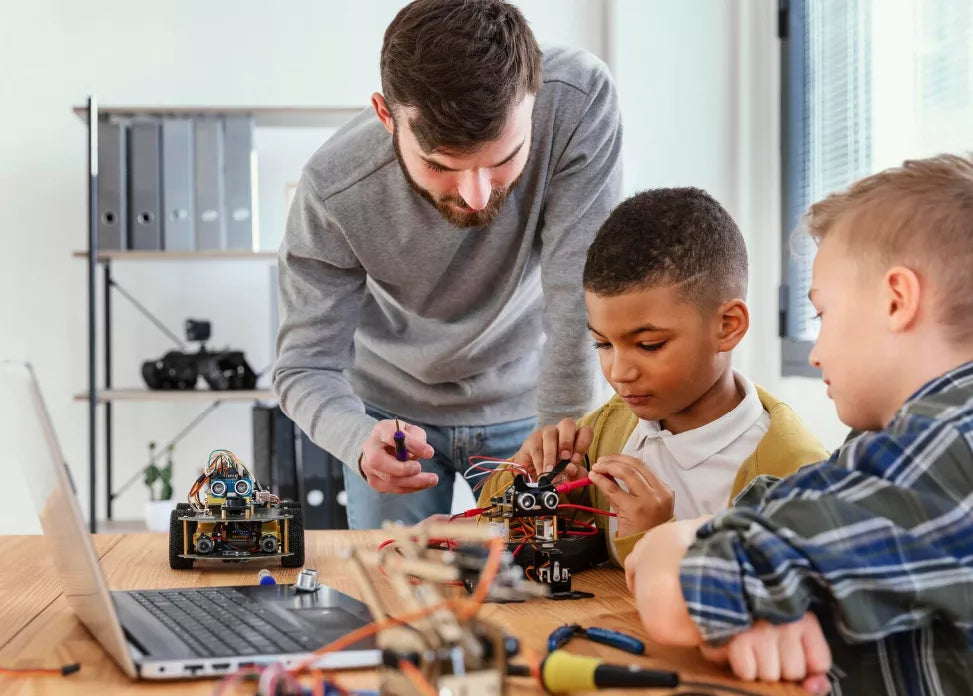
STEM Teaching Strategies for Your Classroom: How to Elevate the Education Experience
Read stories how our founder Albert turned his childhood passion into CircuitMess, and get exciting DIY project ideas you can do with your kids at home for free.
Table of content
If you're reading this, the chances are that you're looking for ways to make the science, technology, engineering, and mathematics (STEM) curriculum in your classroom more engaging.
You're in the right place—we've prepared a brief (we know you're busy!) overview of STEM education, its challenges, and proven strategies for success.
STEM education: what does it really mean?
As you've probably seen with your students, memorizing formulas does not a successful STEM lesson make.
Instead, STEM education should aim to make STEM concepts understandable and less abstract. Let's say you were teaching a lesson about fluid conductivity, for example.
A good approach would be to accompany the theory with visual aids like the one below.

But it would be even more effective to let the students see firsthand how the concept works in practice.
Salt, water, wires, an, LED, and a few other materials are all the students need to construct a basic circuit that demonstrates the conductivity of saltwater. Much better than merely showing a presentation about positive charge, ions, and electrical current theory, right?

It's STEM activities like these that truly engage students. They help learners visualize problems, develop their critical thinking and problem-solving skills, as well as understand the STEM subjects at hand better.
Real-world applications of STEM education
To continue with our example, such a vivid demonstration of fluid conductivity could be an excellent way to warn the students about why we need to be careful with electricity around water.
Such relevant, real-life applications of science concepts are always more memorable when they connect classroom learning with the students' own experiences.
Ultimately, when students develop a sense of how things taught in STEM lessons are applied in real life, it can show them the potential impact of their knowledge in everyday situations, possibly inspiring future innovation and an interest in STEM jobs.
Wouldn't it feel amazing to know that your classroom might be where a student first thought, "Hey, this stuff actually matters!"?
What are the main challenges in STEM teaching?
If it was up to educators, all students would have access to well-designed STEM programs, complete with the latest technology and fully equipped labs to experiment and explore.
But the reality is often different.
A lot of schools have to juggle tight budgets and limited resources, which can make it tough to give students that high-tech, firsthand learning experience every STEM teacher dreams of.
The lack of relevant materials, in turn, frequently results in demotivated students who struggle to see the connection between their classroom STEM experiences and the real world.
You can see how this creates a cycle where a lack of quality STEM education leads to limited engagement. Luckily, there are multiple ways to break this cycle and enable students to explore the world of STEM, even with limited resources.
How to face them?
The first factor that you can change is the learning environment itself. In fact, the research staff at Accelerate Learning considers the environment one of the main factors that teachers can control, even with budget constraints.

So, how do you change the environment in your class?
You could start by reorganizing the classroom to facilitate teamwork. This simple shift can turn your class into a place of collaboration, where students develop interpersonal skills, solve problems together, and feel more involved.
The next element to consider is the choice of materials used for teaching.
Sure, you can get creative with everyday items for experiments (you can find some great ideas here and here). But even baking soda or AAA batteries can add up over time, which isn't the cost you'd want to bear, especially given that most teachers spend their own money on school supplies.
An average public school teacher spends $673 of their own money per year on school supplies!
That's where finding a STEM kit provider who offers educator discounts can be a game changer. This approach introduces students to tools and technologies that might otherwise be inaccessible, taking their learning experience to a new level.
You can find educator-friendly suppliers for different STEM activities across chemistry, computer science, engineering, and more. Most likely, there's something for your area, too, no matter how niche your STEM lessons are.
Now, whether you decide to work with specialized kits or improvise with available resources, the key is to apply effective teaching strategies that resonate with your students. Let's see what these are.
Best STEM teaching strategies you should consider
Remember, the strategies we'll see aren't mutually exclusive. If anything, your students can benefit from a bit of mixing and matching, so don't hesitate to experiment and find the combination that works best for you.
Hands-on STEM learning
Simply put, hands-on STEM learning means getting your students directly involved in the learning process through physical activities and experiments.
Whether you're mixing acids and bases to observe chemical reactions or creating 3D models in computer science courses, hands-on learning will enhance comprehension, spark curiosity, and encourage students to ask questions in real time.
Project-based learning
Project-based learning takes STEM to the next level because it requires students to apply their skills and knowledge from start to finish.
Rather than just participating in segments of lessons, it's a comprehensive approach where students dive into extended projects, such as building a robot, designing an app, or conducting a scientific research study.

To do such projects, students need to carefully plan, research in depth, design, execute, and then evaluate their projects.
In addition to applying their classroom knowledge to real projects, project-based education also helps students learn time-management skills. And as they move through multiple stages of a project, they are taught focus and persistence—qualities that are crucial in school and beyond.
Collaborative learning
Numerous studies, like this one for example, have shown that collaboration in learning brings multiple benefits. Increased communication and social skills, problem-solving abilities, and enhanced creativity are just some of them.
So, why not engage students with this approach in your next lesson? Math, computer science, robotics, and other subjects from different STEM fields lend themselves perfectly to collaboration.
Integration of technology
Technology in the class isn't just about sneaky TikTok sessions or distracting text messages.
It's a powerful tool that we as teachers should embrace and use to engage students, considering how integrating technology into lessons can transform the way students interact with STEM subjects.
Students are already immersed in the tech world, which gives teachers an opportunity to connect with them on familiar ground. By using apps or gadgets, we can incorporate technology, making STEM subjects more relatable and accessible.
Best STEM teaching success stories
Often, we think it's just kids who might struggle with motivation, but trying out new ideas can be daunting for adults, too. To give you a little nudge of inspiration, we’re going to share two success stories.
These aren't just tales of triumph; they're real-life examples of what can happen when you embrace creative STEM strategies in education.
STEM success story #1
Meet Marianne Green, a computer science teacher to grade levels two to eight. Below, you can see a balloon-powered car and a paper roller coaster, which are some of the projects that her students have created in class.

What do these engineering-based projects have to do with computer science, you might be asking.
Well, Green's approach is all about contextualizing the engineering design process used in CS. That's why the teacher creatively linked these analog activities to CS topics such as troubleshooting, computational thinking, iteration, and collaboration.
Clearly, Green's story shows how in the world of STEM, you're not confined to just one discipline. With some creativity, you can build bridges, resulting in an interdisciplinary way to teach students STEM subjects.
STEM success story #2
Similarly, our next story describes how music can come together with technology, engineering, and math to create a truly innovative learning experience.
We know that this may sound like an unusual combination. However, Joseph Kharige from Math Thru Music witnessed firsthand how STEM topics, like mathematics and coding, become much more engaging with the right tools.
In collaboration with CircuitMess, Math Trhu Music used Jay D kits, allowing students to discover for themselves that the art of DJing has a big overlap with STEM.

This approach made learning more interactive, while also allowing students to creatively explore and understand the technical aspects behind music production. In other words, students became creators rather than consumers, which is a core value of both organizations.
The combination of science and music also supported Math Thru Music's mission to demonstrate the origins of DJing in the context of social justice, along with the entrepreneurial potential of DJing.
As you can see, STEM kits can do much more than simply teach technical skills. They're the starting point, but it's the way you use kits that brings these STEM sidekicks to their full potential.
Integrate CircuitMess kits in your STEM lessons
So, do STEM kits sound like something you'd want for your students?
If you'd like to provide students with exciting and engaging learning experiences related to engineering and robotics, check out our Educators Program.
Partnering with CircuitMess will help you teach hardware engineering, computer science, and encourage your students to create pieces of real technology.
Not sure whether we'd be a good match? Fill in the contact form, and we'll happily discuss how our kits can align with your teaching goals. Here's to you and your students engineering many amazing projects!
Read stories how our founder Albert turned his childhood passion into CircuitMess, and get exciting DIY project ideas you can do with your kids at home for free.
Read more

What is STEM? A Fun and Future-Focused Way to Learn
The future demands adaptable and innovative minds. This guide breaks d...

Is Your Child Ready to Become a Space Explorer? (Here's How)
Your portal to space exploration. Build robots, code games, and unlock...

DIY Delights: 5 Easy Electronics Projects for Kids
Join thousands of parents inspiring their kids with these 5 easy elect...
